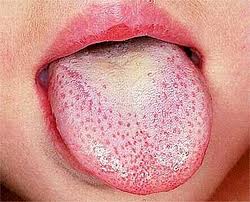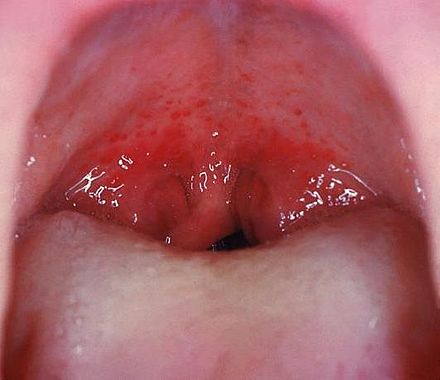Scarlet Fever
Scarlet fever, also known as scarlatina, is an infectious disease caused by Streptococcus pyogenes, a Group A streptococcus (GAS). It primarily affects children aged 5–15 years. The disease is characterised by a sudden onset of sore throat, fever, and malaise, progressing to a distinctive rash.
Signs and Symptoms
Scarlet fever typically begins with a sore throat, fever, and headache. Other early symptoms include swollen lymph nodes, nausea, vomiting, and abdominal pain. A characteristic rash follows the initial symptoms, appearing as diffuse redness with small bumps, often described as "scarlatiniform" and resembling goosebumps. The rash usually starts on the neck or torso before spreading to the arms and legs, and it feels rough like sandpaper. It generally spares the palms and soles.

The face may appear flushed with a pale area around the mouth. The tongue initially has a whitish coating with protruding red swollen papillae, known as "white strawberry tongue," which later transforms into a "red strawberry tongue" as the coating sheds.


Diagnosis
Diagnosis is usually clinical, supported by a history of exposure to someone with strep throat. Confirmation is obtained through a throat culture or a rapid antigen detection test. The throat culture is considered the "gold standard" for diagnosing scarlet fever. Serologic tests, such as antistreptolysin-O and antideoxyribonuclease B, can identify previous streptococcal infections but are not useful for diagnosing current infections.


Treatment
Scarlet fever is treated with antibiotics, primarily to reduce symptoms, prevent complications, and limit the spread of infection. The antibiotic of choice is Penicillin V, taken orally for ten days. Amoxicillin is an alternative for children who cannot take tablets. For those allergic to beta-lactam antibiotics, clindamycin or erythromycin can be used. The disease is no longer contagious 24 hours after starting antibiotics.
Complications
Complications of scarlet fever can be divided into suppurative and nonsuppurative categories. Suppurative complications include cellulitis, abscesses, and sinusitis, arising from the direct spread of bacteria. Nonsuppurative complications result from autoimmune responses and include acute rheumatic fever, poststreptococcal glomerulonephritis, and poststreptococcal reactive arthritis. Rheumatic fever, which can develop 2–6 weeks after infection, is particularly concerning as it can lead to chronic rheumatic heart disease.
Prevention
Preventative measures include frequent handwashing, not sharing personal items, and avoiding close contact with infected individuals. There is no vaccine available for scarlet fever, although research is ongoing. Long-term antibiotic prophylaxis may be indicated for individuals who have had complications like recurrent rheumatic fever.
Epidemiology
Scarlet fever was once a leading cause of death in children but has become less severe due to better living conditions and the advent of antibiotics. Recent outbreaks, such as those in Hong Kong in 2011 and the UK in 2014, highlight the emergence of antibiotic-resistant strains. The disease sees a peak in colder months and predominantly affects children aged 5–15 years.

History
Scarlet fever has been documented since ancient times, with notable historical descriptions by physicians such as Hippocrates and Giovanni Filippo Ingrassia. The association of streptococci with the disease was established in the late 19th and early 20th centuries, leading to the development of diagnostic tests and treatments.


Self-assessment MCQs (single best answer)
Scarlet fever is caused by:
Which age group is primarily affected by scarlet fever?
What is the characteristic appearance of the tongue in the later stages of scarlet fever?
Which diagnostic test is considered the "gold standard" for diagnosing scarlet fever?
What is the first-choice antibiotic for the treatment of scarlet fever?
Which of the following is a nonsuppurative complication of scarlet fever?
Which of the following is NOT a symptom of scarlet fever?
Scarlet fever rash usually spares which parts of the body?
What preventive measure is NOT mentioned for scarlet fever?
Who developed an antitoxin and vaccine for scarlet fever in 1924?
Dentaljuce
Dentaljuce provides Enhanced Continuing Professional Development (CPD) with GDC-approved Certificates for dental professionals worldwide.
Founded in 2009 by the award-winning Masters team from the School of Dentistry at the University of Birmingham, Dentaljuce has established itself as the leading platform for online CPD.
With over 100 high-quality online courses available for a single annual membership fee, Dentaljuce offers comprehensive e-learning designed for busy dental professionals.
The courses cover a complete range of topics, from clinical skills to patient communication, and are suitable for dentists, nurses, hygienists, therapists, students, and practice managers.
Dentaljuce features Dr. Aiden, a dentally trained AI-powered personal tutor available 24/7 to assist with queries and provide guidance through complex topics, enhancing the learning experience.
Check out our range of courses, or sign up now!


